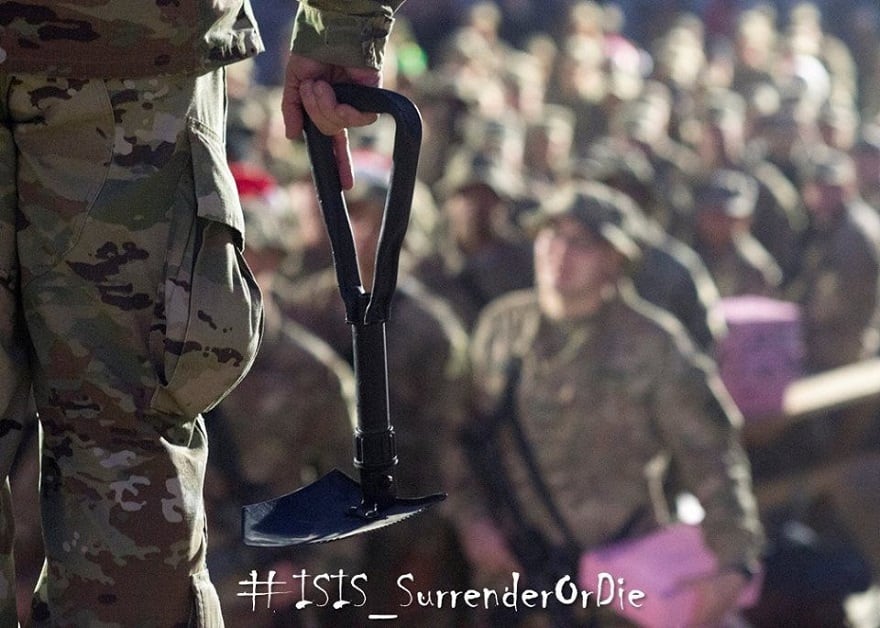In 1951, Medal of Honor recipient U.S. Army 1st Lt. Benjamin F. Wilson found a weapon of last resort in the entrenching tool.
His unit had come upon a much larger enemy force in Hwach’on-Myon, Korea. Wilson dashed into enemy fire to assist members of his unit who were pinned down and he killed four enemy fighters with his rifle and grenades.
Wilson then “led a bayonet attack, which ... killed approximately 27 hostile soldiers,” according to his Medal of Honor citation.
But enemy forces launched another counterattack.
“First Lieutenant Wilson, realizing the imminent threat of being overrun, made a determined lone-man charge, killing seven and wounding two of the enemy, and routing the remainder in disorder.”
A third assault ensued, prompting Wilson to resort to fighting with his entrenching tool.
“Unhesitatingly, First Lieutenant Wilson charged the enemy ranks and fought valiantly, killing three enemy soldiers with his rifle before it was wrested from his hands, and annihilating four others with his entrenching tool,” his award citation read.
“His courageous delaying action enabled his comrades to reorganize and effect an orderly withdrawal. While directing evacuation of the wounded, he suffered a second wound, but elected to remain on the position until assured that all of the men had reached safety.”
The value of the entrenching tool, or “etool,” which is a shovel issued to soldiers and Marines, has come back into the spotlight in recent days after Command Sgt. Maj. John Troxell used it to rally forces over the holidays and via Twitter.
Troxell challenged Islamic State fighters to surrender or die and said that U.S. troops could kill them “by beating them to death with our entrenching tools.” Troxell is the senior enlisted adviser to Chairman of the Joint Chiefs Gen. Joseph Dunford.
The Military Times Hall of Valor includes many citations for medals and awards that U.S. service members have earned for relying on their entrenching tool as a weapon of last resort.
In 1969, Silver Star recipient U.S. Marine Corps Pfc. Lewis Grover was without his weapon in Quang Nam Province, Vietnam, when he spotted a lone Viet Cong fighter in a bunker.
Grover, a rifleman with Company H, 2nd Battalion, 5th Marines, was tasked to refill all of the canteens for his unit when he spotted the enemy. Grover pretended not to notice the fighter, then quietly picked up an entrenching tool he found on the river bank.
“He then maneuvered to a position from which he could approach the bunker entrance unseen. When an enemy soldier carrying an automatic weapon came out of the bunker, Private First Class Grover, armed only with the entrenching tool, unhesitatingly attacked the Viet Cong,” his award citation reads.
Finally, there is Medal of Honor recipient U.S. Army Pfc. Anthony T. Kaho’ohanohano.
In 1951, Kaho’ohanohano was out of ammunition, wounded and determined to provide cover for retreating friendly forces in Chup’a-ri, South Korea.
Kaho’ohanohano was in charge of a machine gun squad supporting Company H, 2nd Battalion, 17th Infantry Regiment, 7th Infantry Division, when the unit was overrun by a much larger enemy force.
“Private Kaho’ohanohano fought fiercely and courageously, delivering deadly accurate fire into the ranks of the onrushing enemy,” his award citation read.
“When his ammunition was depleted, he engaged the enemy in hand-to-hand combat until he was killed. His heroic stand so inspired his comrades that they launched a counterattack that completely repulsed the enemy. Coming upon Private Kaho’ohanohano’s position, the friendly troops found 11 enemy soldiers lying dead before it and two in the emplacement itself, beaten to death with an entrenching shovel.”
Tara Copp is a Pentagon correspondent for the Associated Press. She was previously Pentagon bureau chief for Sightline Media Group.





